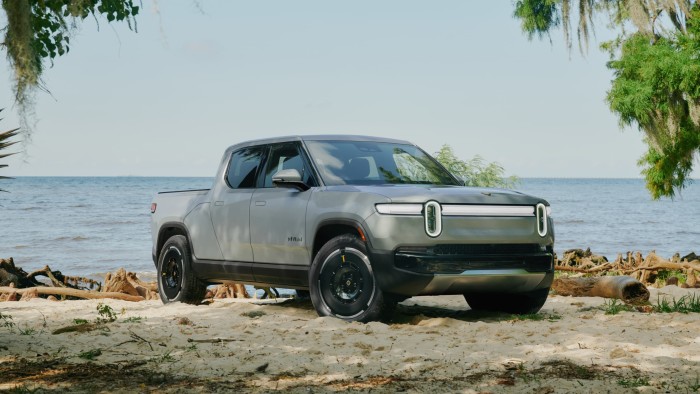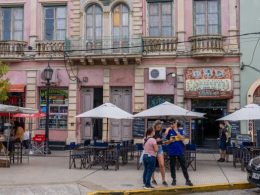Unlock the Editor’s Digest for free
Roula Khalaf, Editor of the FT, selects her favourite stories in this weekly newsletter.
Inside each of us there are two babes. Your inner “babe!” is positive, proactive and represents the extent to which you are, at any given moment, thriving. Your “babe?” side, on the other hand, encourages the kind of questionable behaviour that is likely to cause concern for your wellbeing among friends and loved ones. This duality, codified by author and podcaster Lara Marie Schoenhals, came to mind recently as I was driving down Highway 101, the concrete artery connecting the San Francisco Bay Area to Silicon Valley. Side by side in my rearview were two pickup trucks, alike in size but unalike in dignity.
One was a silvery Cybertruck, Tesla’s triangle-forward culture-war-on-wheels. Even before Elon Musk took to Washington DC like Darth Maul, the semiotics of the Cybertruck were complicated. Still, it looks exactly like a vehicle that comes with an air-filtration system called “Bioweapon Defense Mode”. It’s “babe?” incarnate.
In the next lane over was a light-grey Rivian R1T, a more-or-less conventional-looking truck given a futuristic glow-up with gently rounded edges, a huge light bar across the front fascia and headlamps arranged in a neat, vertical stack. It looked cute but capable, like a butched-up Pixar character. Total “babe!”.
Founded in 2009, California-based Rivian went public a few years ago, making history as the first manufacturer to sell consumer EV pickups. Rivian, which produces vehicles in a factory located in Normal, Illinois, struggled through a semiconductor shortage, the pandemic and quality and reliability problems during its early years. But things have stabilised since then. The company doesn’t yet sell in Europe, but plans to introduce a smaller, more Euro-appropriate SUV, the R2, likely in 2027.

In the meantime, Rivian’s first two models, the pickup and its SUV cousin, the R1S, clearly won hearts and minds in and around Silicon Valley. Teslas still abound here, to be sure. But, Cybertruck aside, there are so many of that company’s sameish-looking sedans and SUVs now that they tend to blend into the background. Rivians, whether precariously perched on driveways in the Marin Hills or stationed near the Stanford Shopping Center, seem to stand out. How, I wondered, did Rivian become the It car in Tesla’s own backyard?
There are practical reasons. Rivians were genuinely the first to do things EVs haven’t traditionally been great at. R1Ts, for example, have the adjustable air suspension and attendant off-roading equipment to rock crawl with the Land Rover Defenders of the world. They can tow a beefy 11,000lb, when properly equipped, and cart a 1,764lb payload. Plus they offer tons of optional goodies for outdoorsy types, from an air pump in the back, for inflating water toys, tyres and the like, to a handy little flashlight that pops out of the driver’s side door.
I approached a few random Rivian owners – at a trailhead and a beach parking lot – who suggested their choice to buy one hadn’t been entirely practical, before indicating they really were ready to get on with their cardio. Clearly vibes are a variable in the Rivian equation.

I contacted Carter Gibson, a friendly 34-year-old employee at Google, who lives in San Francisco and owns an R1T Launch Edition. He told me he used to be a Toyota 4Runner guy, who loved the 4×4’s dependability and capability but always felt guilty about the lousy gas mileage. Then Rivian announced the R1T, which he felt was “specifically targeted to me. They showed it going down a trail completely silent. They were saying you could drive your car without dripping oil down the trail. That resonates with me much more than, ‘This thing is bulletproof,’” he said, referencing another of Tesla’s early talking points about the Cybertruck. “I don’t like to celebrate dystopians.”
How far being an It car goes in securing sales in the long term is anybody’s guess. But Rivian’s predecessors that earned that status in California – Tesla’s early cars and the Toyota Prius before – have fared just fine globally. “I hope the Rivian becomes a classic,” Gibson said. “It is a classic.”
Gibson clued me into something else I hadn’t considered: Rivian’s It-car status is a marker of what hasn’t changed. Namely, that the values of the people who actually live in northern California – earnest optimism, reverence for nature and a genuine desire to do the right thing, especially if that means buying something luxurious – are well intact.
Source link









